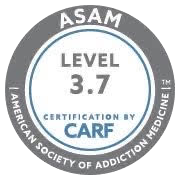Fentanyl overdose is a significant and pressing public health concern right now because of the potency of the drug and its widespread availability. Preventing overdose requires a multifaceted approach, including education, harm reduction strategies, and access to medical interventions.
When we talk about preventing fentanyl overdoses, it can be in the context of the individual level. For example, maybe you have a loved one you’re concerned about. It can also be more geared toward the community context.
Why Is the Risk of Fentanyl Overdose So High?
Fentanyl is a synthetic opioid and is significantly more potent than others, like heroin and morphine. What it does share in common with other opioids is how it affects the brain—through binding with opioid receptors. When the drug binds to those receptors, fentanyl changes how you perceive pain and induces euphoric feelings. The potency of fentanyl significantly increases the risk of overdose, however.
Even tiny amounts can lead to an overdose.
When a person takes fentanyl, and it binds to their brain’s opioid receptors, it activates the reward system in the brain. That’s what contributes to those pleasurable feelings associated with fentanyl and other opioids, as well as relaxation. It also depresses the central nervous system, slowing breathing and heart rate.
If you take high doses or combine opioids with other things that suppress the central nervous system, like alcohol, the risk of overdose is even greater.
Fentanyl has taken a center-stage role in the opioid epidemic. While initially developed as a pain reliever in strictly controlled medical settings, illicitly manufactured fentanyl has since flooded the illegal drug market. It’s often mixed into heroin or pressed into counterfeit pills as drug traffickers like the potency and low production costs of fentanyl. Frequently, people do not know they’re taking it.
Unfortunately, not knowing you’re taking something containing fentanyl increases the risk of overdose.
Fentanyl has become increasingly available, and as such, it’s contributed to a recent surge in deaths related to opioid overdoses.
How Much Stronger Is Fentanyl Than Other Opioids?
Estimates put fentanyl’s potency at anywhere from 50 to 100 times more than morphine and around 50 times stronger than heroin. As a result, even small amounts have profound effects, including intense euphoria, but also a very narrow margin between a therapeutic dose and a lethal dose.
A dose of fentanyl that’s equal in weight to a few grains of salt can be deadly. When fentanyl is mixed with other drugs or substances, it makes it even more lethal.
Even handling fentanyl in medical settings requires care, but illicitly made fentanyl is more dangerous because of the unregulated production and the variation in potency between batches. A user can’t gauge how strong the fentanyl they’re consuming, increasing the accidental overdose risk. Fentanyl slows breathing, and during an overdose, the effect becomes severe, leading to shallow, labored breathing and sometimes a complete stop.
Preventing Fentanyl Overdose at An Individual Level
Whether you have concerns about fentanyl for yourself or a loved one, the best thing to do to avoid an overdose is not to use substances. People are increasingly buying drugs on the street they think are something else, like Xanax, for example, and they’re tainted with fentanyl.
Outside of avoiding unregulated and illegally sold substances, other ways to prevent fentanyl overdoses at an individual level include:
- Education and awareness: Learning more about the risks of fentanyl use can help with fentanyl overdose prevention. This could include learning about how strong it is and the high risk of overdose. If you have a loved one who uses drugs, you might want to educate yourself to recognize overdose signs and know how to respond if an emergency does happen.
- Naloxone: It’ll be discussed more below, but anyone who uses opioids or other substances, as well as people around them, should have access to naloxone. Naloxone is a medicine that reverses opioid overdoses and can save lives when used effectively.
- Safe use practices: If you use substances or want to help someone who does, encourage them to practice harm reduction strategies. These include small test doses, not using drugs alone, and not mixing them with other substances, all of which can help reduce the risk of overdose.
- Seek support and treatment: If you’re struggling with opioid addiction or someone you know is, they should be encouraged to seek treatment and support services. This might include medication-assisted treatment, counseling in a professional rehab environment, and peer support groups.
When people have timely access to treatment, it reduces their overdose risk and also helps to promote long-term recovery.
Preventing Overdoses at the Community Level
In communities and organizations, overdose prevention strategies might include:
- Harm reduction services: Supervised consumption sites, needle exchanges, and outreach services can be critical to people at risk of overdose. These programs offer an environment to access education, resources, and naloxone.
- Drug-checking programs: A community-based drug-checking program lets users test the potency and composition of substances before using them. These programs help identify if fentanyl is present in illicit drugs for informed decision-making and lower overdose risk.
- Public health policies: The implementation of evidence-based public health policies at a community level can reduce the misuse and availability of fentanyl. This might include regulations on how opioids are prescribed, prescription drug monitoring programs, and efforts to curb illicit production and distribution of fentanyl.
- Community engagement: Strong community networks are crucial for preventing fentanyl overdose. This can include engaging members of the community, healthcare providers, law enforcement, and other stakeholders in efforts to reduce stigma, address the opioid epidemic, and provide access to needed prevention and treatment services.
Through implementing overdose prevention strategies at an individual and community level, it’s possible to reduce the harms linked to the use of this potent opioid and save lives.
Using Naloxone
A vital tool in the fight against the opioid epidemic, naloxone (Narcan) is an opioid antagonist medicine that works to displace fentanyl and other opioids by binding to the same receptor sites. Naloxone blocks opioids’ effects, rapidly reversing overdose symptoms, including unconsciousness and respiratory depression.
Naloxone distribution programs are becoming increasingly available, and they often distribute naloxone kits so that people at risk of overdose and their friends, families and caregivers can have it on hand if needed.
Fentanyl Test Strips
Fentanyl test strips are used to detect the presence of fentanyl in substances like cocaine, heroin or counterfeit pills. They’re a fast, inexpensive way to assess drug safety before using them.
The test strips don’t tell the user how much fentanyl could be present or anything about its potency. Instead, they just let the person know if it’s detected or not.
Fentanyl test strips are available through harm reduction programs, online retailers and community organizations. Some locations have started pilot programs to distribute the strips to people who are at risk of overdose.
What Else Can You Do?
While strategies like distributing naloxone and fentanyl test strips mitigate the overdose risk, there’s no foolproof method to prevent overdose except drug abstinence. Fentanyl is unpredictable and potent, and that means any substance use is inherently risky.
Getting professional help for an opioid or other addiction is key. Your best chance for personal recovery or to help someone you love is a program with comprehensive treatment and support services, including medication-assisted treatment and counseling.
Contact our recovery experts to learn more or take the first step.



